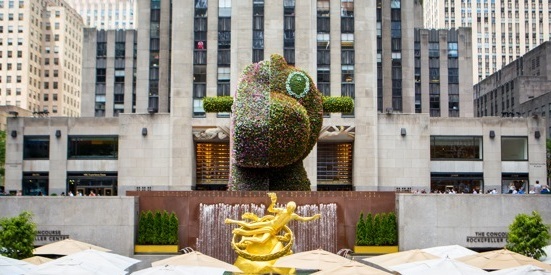Jeff Koons and Kara Walker are far from the first artists to explore the concept of life and death in their artwork. In fact, this concept is the very essence of what the art world constantly seeks to investigate. These artists have both examined this topic by creating and controlling temporary installations that evolve with time. This, in turn, broadens the audience's experience of their work.
Jeff Koons intentionally encourages the growth of the flowers on Split-Rocker, and Kara Walker deliberately let A Subtlety evolve by allowing its sugar-coated sculptures to melt. They both use the temporary fate of their chosen medium to make a statement about life and death.
Split-Rocker, currently at Rockefeller Center, is a toy horse- and dino-shaped metal structure covered with flowers. Though there is an internal watering system built into it, the reality of its most significant component remains that flowers always have the potential to grow, wither and/or die along the way. The very essence of the piece and its circumstances don't allow it to exist beyond its intended state or beyond the potential of its expanded state.
With the innocent imagery of a child's toy horse as his figurative mask, Koons plays with the idea of life and death -- the flowers can symbolize the frailty of life, while the water system "toys" with the predictability of death. Koons' control of the installation with an irrigation system is a way of encouraging the growth, and preventing the inevitable death, of the flowers. The flowers' demise always remains just under the surface of examination.
Kara Walker's A Subtlety, which closed earlier this month after causing quite a stir at the ill-fated Domino Sugar Refinery in Brooklyn, featured a massive African female sphinx sculpture surrounded by smaller child-like sculptures. All were coated in sugar or molasses. The exhibition was as different as night and day from Split-Rocker. That said, much like Koons' flowers, A Subtlety was made from a medium that had the potential to -- and did -- melt, collapse and disfigure the original pieces.

(photo source: CreativeTime.com)
Incidentally, Walker plays with the idea of life and death as well -- albeit in a more intensely symbolic and historically-rich way than Koons. While Split-Rocker's water system was put into place to prevent the flowers from changing with time, Walker embraced the inevitability of time and decay. In fact, it was directly related to her message -- the sculpture recalls the cane fields in which African slaves labored. "I knew that the candy wouldn't last." Walker told NPR. "That was part of the point. That [the sculptures] were going to be in this non-climate-controlled space, slowly melting away and disintegrating." The "death" of sugar sculptures inside a soon-to-be-demolished sugar refinery, and the representation of the African slave as a commentary of the history of the sugar trade, gives A Subtlety an added level of meaning.
Work that develops beyond the original form created by the artist, even when that change is intended, removes control from the artist and instead transfers it to nature and the environment. This commands an important shift of focus from the artist's intent to the audience's experience: an evolving work provides an evolving or varied experience. The audience is further challenged and enriched when the scope of a piece changes from one day to the next. For example, those visiting A Subtlety later in the exhibition would have witnessed the melting of sculptures unlike those who visited earlier, thereby experiencing the installation in a much different way. (Of course, this is not only true for public art. Remember when Yoko Ono exhibited a rotting apple?)
The impermanence introduces an element to the work that, due to its fleeting nature, is almost interactive. Provocative dance pieces and moving theatrical performances remain memorable despite the fact that they are momentary. The idea that the pieces will only exist temporarily makes it more immediate and speaks to a moment in time. How apropos for these two pieces that examine life and death. Perhaps it's even more powerful when works like these slip into the ether. Its brief life span, when anchored with intense meaning, makes them all the more precious. Though fleeting and impermanent in physical form, their stamp on the art world has the potential to stick for quite some time.
